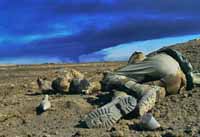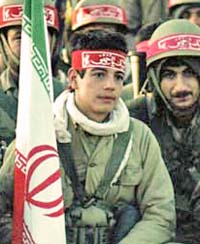Mullahs' War
 On June 17, 1982, Iraq proposed a ceasefire that required the complete withdrawal of its troops within two weeks and a resolution of disputed issues through binding arbitration. Khomeini rejected the offer.2 For the Ayatollah, the war offered an opportunity to expand the Islamic revolution to Iraq, an obsession he had long held, and consolidate power within Iran.3
On June 17, 1982, Iraq proposed a ceasefire that required the complete withdrawal of its troops within two weeks and a resolution of disputed issues through binding arbitration. Khomeini rejected the offer.2 For the Ayatollah, the war offered an opportunity to expand the Islamic revolution to Iraq, an obsession he had long held, and consolidate power within Iran.3
Three days after the ceasefire proposal, Iraq declared it would unilaterally withdrawal of all forces from Iran within ten days. This action and Khomeini's refusal to end the conflict turned the tables, making Iran the aggressor force. From this point onward the conflict became the Mullahs' War.
The People's Mojahedin disagreed with Khomeini's decision. It declared there was no longer any reason to shed Iranian blood and called for an immediate truce. A prolongation of hostilities, it said, was unpatriotic and not in the interest of the Iranian people. Massoud Rajavi, head of the PMOI, explained that Khomeini was "the only person calling for the continuation of war" because it served to extend his power.4
Conditions in Iran at this time were unbearable. Mansour Farhang, Iran's first ambassador to the United Nations, described life in Iran as a consequence of the war and the mullahs' oppressive policies:
"Iranian people know that if it wasn't for Khomeini's incompetence, the Iraqis would never have dared to attack us. Two million refugees. The largest oil refinery in the world completely ruined. More than $200 billion in material destruction. More than 100,000 killed and more than 250,000 wounded. We have close to 5 million unemployed. The entire university system is shut down...There are more than 50,000 Iranians in prison and 20,000 executed...inflation is 50 percent, 60 percent. People have to stand in line to get their bread. They get meat once a month."5
The mullahs turned their back on the public's suffering and pursued their war against Iraq, regardless of the costs.
Iran's Youth Sent to Their Death
As hostilities dragged on, more and more young Iranians refused  to join the army. To make up for the shortfall in new recruits, Khomeini sent "mullahs and war veterans across the countryside to schools and mosques" to sign up underage boys who were coerced to join the war. Poor illiterate youths from religious families were the most vulnerable.6
to join the army. To make up for the shortfall in new recruits, Khomeini sent "mullahs and war veterans across the countryside to schools and mosques" to sign up underage boys who were coerced to join the war. Poor illiterate youths from religious families were the most vulnerable.6
The child soldiers, some as young as nine years old, were given minimal training and then transported to the front lines, wearing red martyr bandannas and metal strips with serial numbers called "keys to paradise" around their necks.7
The boys were told if they died in battle they would  go straight to paradise. "The regime employed professional actors to play the role of the Hidden Imam, appearing at decisive moments to urge the child soldiers to flood the minefields or jump under enemy tanks to stop them."8
go straight to paradise. "The regime employed professional actors to play the role of the Hidden Imam, appearing at decisive moments to urge the child soldiers to flood the minefields or jump under enemy tanks to stop them."8
The innocent youths were often sent in human waves in assaults against heavily fortified Iraqi defenses. In some cases, groups of about 20 children were bound together by ropes to prevent escape before being sent to battle.9
The number of Iranian children killed as a result of the Mullas' War is estimated to be more than 100,000, most between 12-15 years old.
Solidifying Power
Khomeini used the conflict with Iraq to solidify his power. Descent of any kind was prohibited because of the war. The mullahs jailed, tortured, and murdered thousands of Iranians who opposed their theocratic regime.
Under the Shah, there had been about 3,000 political prisoners. Khomeini imprisoned 150,000 political opponents in the early 1980s.11 His regime executed more than 100,000 people, "mostly on charges that would never stand in a traditional court."12
1) "International News." Associated Press. June 20, 1982.
2) "Khomeini Declares Continued War with Iraq." June 21, 1982.
3) "Enemies of the Ayatollahs." Mohammad Mohaddessin. Zed Books, London, New York. 2004.
4) "Iraqi Visits Iranian Leftist in Paris." New York Times. January 10, 1983.
5) "Mansour Farhang, Top Khomeini Ally Who Fled Iran, Talks to Don Oberdorfer." Washington Post. November 28, 1982.
6) "Iran: The Youngest Martyrs." Newsweek. March 31, 1983.
7) "New Attack on Basra Stymied, Iraq Says." The Globe and Mail (Canada). July 23, 1982.
8) "Iran: The Youngest Martyrs." Newsweek. March 31, 1983.
9) "Iran: Five Years of Fanaticism." New York Times. February 12, 1984.
10) Ibid.
11) "The Persian Nights: Iran Under the Khomeinist Revolution." Amir Taheri. Encounter Books. 2008.
12) Ibid.

